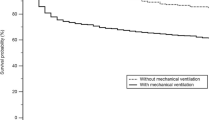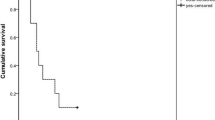Abstract
Introduction
In contrast to information on the effects of organophosphate, pesticide, or environmental exposures, data on cholinergic crisis caused by pharmaceutical cholinesterase inhibitors are sparse. The present study aimed to describe the characteristics, demographics, and mortality of patients with cholinergic crisis caused by pharmaceutical cholinesterase inhibitors using a nationwide inpatient database in Japan.
Methods
We identified patients diagnosed with cholinergic crisis as a result of taking cholinesterase inhibitor medications in the Japanese Diagnosis Procedure Combination inpatient database from July 2010 to March 2016. We examined the patients’ characteristics, treatments, and mortality.
Results
A total of 235 patients with cholinergic crisis were identified during the 69-month study period. Forty-eight patients required mechanical ventilation (20.4%), and 15 patients died (6.4%) in hospital. The median lengths of hospital stay and intensive care unit stay were 15 days (interquartile range, 6–42) and 4 days (2–8), respectively. Approximately half of all hospitalized patients required catecholamines, atropine, or mechanical ventilation, while the other half did not require any of these treatments. Patients who required catecholamines, atropine, or mechanical ventilation were more likely to die and had longer hospital stays.
Conclusions
Cholinergic crisis caused by pharmaceutical cholinesterase inhibitors is a rare but potentially life-threatening condition. Patients who require mechanical ventilation and catecholamines or atropine have a poorer prognosis.
Similar content being viewed by others
References
Gorecki L, Korabecny J, Musilek K, Nepovimova E, Malinak D, Kucera T, et al. Progress in acetylcholinesterase reactivators and in the treatment of organophosphorus intoxication: a patent review (2006-2016). Expert Opin Ther Pat. 2017;27(9):971–85.
Lushington GH, Guo JX, Hurley MM. Acetylcholinesterase: molecular modeling with the whole toolkit. Curr Top Med Chem. 2006;6(1):57–73.
Marrs TC. Organophosphate poisoning. Pharmacol Ther. 1993;58(1):51–66.
Korabecny J, Andrs M, Nepovimova E, Dolezal R, Babkova K, Horova A, et al. 7-Methoxytacrine-p-anisidine hybrids as novel dual binding site acetylcholinesterase inhibitors for Alzheimer’s disease treatment. Molecules. 2015;20(12):22084–101.
Nepovimova E, Korabecny J, Dolezal R, Babkova K, Ondrejicek A, Jun D, et al. Tacrine-trolox hybrids: a novel class of centrally active, nonhepatotoxic multi-target-directed ligands exerting anticholinesterase and antioxidant activities with low in vivo toxicity. J Med Chem. 2015;58(22):8985–9003.
Alonso D, Dorronsoro I, Rubio L, Muñoz P, García-Palomero E, del Monte M, et al. Donepezil-tacrine hybrid related derivatives as new dual binding site inhibitors of AChE. Bioorg Med Chem. 2005;13(24):6588–97.
Komloova M, Musilek K, Dolezal M, Gunn-Moore F, Kuca K. Structure-activity relationship of quaternary acetylcholinesterase inhibitors—outlook for early myasthenia gravis treatment. Curr Med Chem. 2010;17(17):1810–24.
Sugaya K, Onaga T, Nishijima S, et al. Relationship between serum cholinesterase level and urinary bladder activity in patients with or without overactive bladder and/or neurogenic bladder. Biomed Res. 2007;28(6):287–94.
Sugimoto K, Akiyama T, Shimizu N, Matsumura N, Hashimoto M, Minami T, et al. Acotiamide hydrochloride hydrate added to combination treatment with an alpha-blocker and a cholinergic drug improved the QOL of women with acute urinary retention: case series. Res Rep Urol. 2017;9:141–3.
Hetherington KA, Losek JD. Myasthenia gravis: myasthenia vs. cholinergic crisis. Pediatr Emerg Care. 2005;21(8):546–8. quiz 549–51
Abedin MJ, Sayeed AA, Basher A, Maude RJ, Hoque G, Faiz MA. Open-label randomized clinical trial of atropine bolus injection versus incremental boluses plus infusion for organophosphate poisoning in Bangladesh. J Med Toxicol. 2012;8(2):108–17.
Hameed A, Charles TJ. Cholinergic crisis following treatment of postoperative urinary retention with distigmine bromide. Br J Clin Pract. 1994;48(2):103–4.
Yamanaka S, Fujita I, Murota T, Kawakita M, Matsuda T. Cholinergic crisis following administration of distigmine bromide: a case report. Hinyokika Kiyo. 2002;48(1):21–3. Japanese
Tadara R, Kobayashi M, Nakamura N, et al. Patients confined in bed for an extended period and developing cholinergic crisis following administration of distigmine bromide: report of 3 cases. Nihon Naika Gakkai Zasshi. 1998;87(8):1566–7. Japanese
Kobayashi K, Sekiguchi H, Sato N, Hirose Y. Bowel obstruction-induced cholinergic crisis with progressive respiratory failure following distigmine bromide treatment. Chudoku Kenkyu. 2016;29(1):26–9. Japanese
Takahashi M, Ubukata S, Sato E, Shoji M, Morikawa N, Watanabe H, et al. Acute respiratory failure associated with cholinergic crisis: report of five cases and review of the literature. Nihon Kokyuki Gakkai Zasshi. 2011;49(12):877–84. Japanese
Huang X, Liu WB, Men LN, Feng HY, Li Y, Luo CM, et al. Clinical features of myasthenia gravis in southern China: a retrospective review of 2,154 cases over 22 years. Neurol Sci. 2013;34(6):911–7.
Yamana H, Moriwaki M, Horiguchi H, Kodan M, Fushimi K, Yasunaga H. Validity of diagnoses, procedures, and laboratory data in Japanese administrative data. J Epidemiol. 2017;27:476–82.
Mahoney FI, Barthel DW. Functional evaluation: the Barthel index. Md State Med J. 1965;14:56–61.
Shigematsu K, Nakano H, Watanabe Y. The eye response test alone is sufficient to predict stroke outcome—reintroduction of Japan Coma Scale: a cohort study. BMJ Open. 2013;3(4):e002736.
World Health Organization. Obesity: preventing and managing the global epidemic. Report of a WHO consultation presented at: the World Health Organization; June 3–5, 1997; Geneva, Switzerland. Publication WHO/NUT/NCD/98.1.
Wade DT, Collin C. The Barthel ADL index: a standard measure of physical disability? Int Disabil Stud. 1988;10(2):64–7.
Ohta A, Nagai M, Nishina M, Shibazaki S, Ishijima H, Izumida M. Age at the onset of intractable disease: based on a clinical database for patients receiving financial aid for treatment. Nihon Koshu Eisei Zasshi. 2007;54(1):3–14. Japanese
Kalb B, Matell G, Pirskanen R, Lambe M. Epidemiology of myasthenia gravis: a population-based study in Stockholm, Sweden. Neuroepidemiology. 2002;21:221–5.
Tsao TC, Juang YC, Lan RS, et al. Respiratory failure of acute organophosphate and carbamate poisoning. Chest. 1990;98(3):631–6.
Berrih-Aknin S, Frenkian-Cuvelier M, Eymard B. Diagnostic and clinical classification of autoimmune myasthenia gravis. J Autoimmun. 2014;48–49:143–8.
Funding
This work was supported by grants from the Ministry of Health, Labour and Welfare of Japan (H29-Policy-Designated-009 and H29-ICT-Genral-004); the Ministry of Education, Culture, Sports, Science and Technology of Japan (17H04141); and the Japan Agency for Medical Research and Development (AMED).
Author information
Authors and Affiliations
Corresponding author
Ethics declarations
Conflict of interest
The authors declare that they have no conflict of interest.
Rights and permissions
About this article
Cite this article
Ohbe, H., Jo, T., Matsui, H. et al. Cholinergic Crisis Caused by Cholinesterase Inhibitors: a Retrospective Nationwide Database Study. J. Med. Toxicol. 14, 237–241 (2018). https://doi.org/10.1007/s13181-018-0669-1
Received:
Revised:
Accepted:
Published:
Issue Date:
DOI: https://doi.org/10.1007/s13181-018-0669-1




